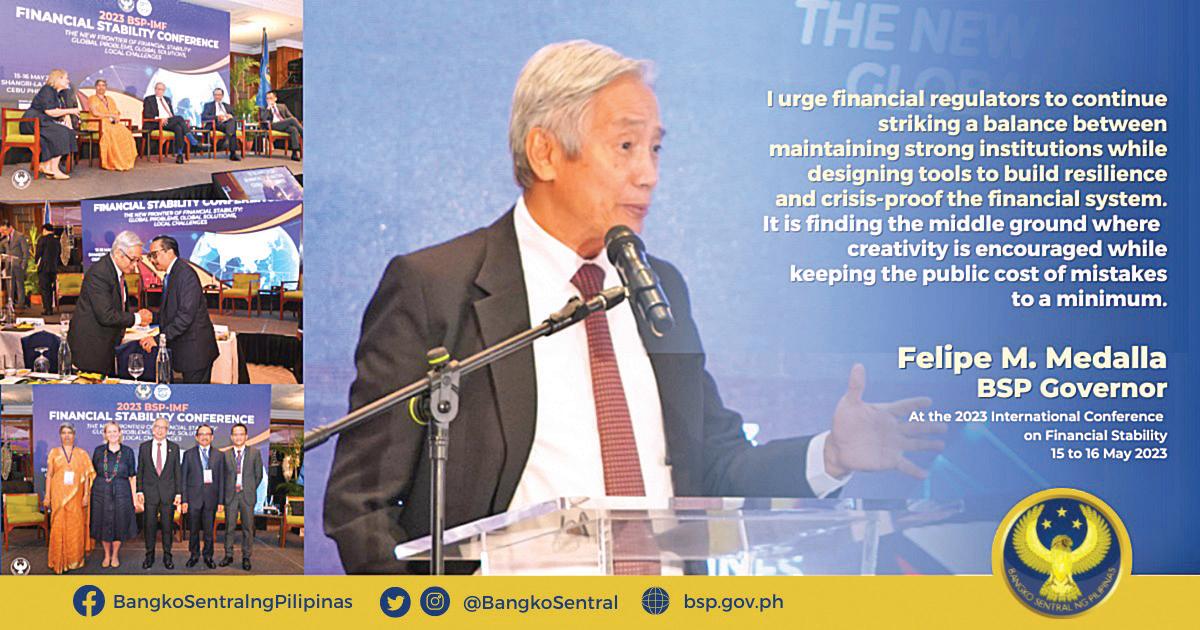
6 minute read
A FUTURE-READY PHILIPPINES: DIGITAL, SUSTAINABLE, INCLUSIVE Strengthening financial stability: Reforms that shaped the Philippine financial system
THE Bangko Sentral ng
Pilipinas marks its 30th year with a banking system that is sound, stable and liquid.
By the end of 2022, the Philippine banking system’s assets stood at P23,047.7 billion, up by 10.7 percent year-on-year. Over the same period, gross total loan portfolio grew by 10.8 percent to P12,625.1 billion. The Philippine banking system also remained well capitalized and managed to keep its exposure to bad debts low. As of end-2022, capital adequacy ratio on solo and consolidated bases stood at 15.7 percent and 16.3 percent, higher than the 10-percent minimum requirement of the BSP and the 8.0 percent prescribed by the Bank for International Settlements. The nonperforming loans ratio settled at 3.2 percent in December 2022 compared with 4.0 percent in the same period of the previous year.
Since its creation in 1993, the Bangko Sentral ng Pilipinas (BSP) has upheld its mandate of maintaining financial stability in the country.

Such is demonstrated by banks and other financial institutions that can effectively meet the service requirements—such as savings, payments, fund transfers, and investments—of individuals, businesses, government institutions, and other stakeholders.
Financial stability is also exhibited when risks that affect the entire financial system, rather than just an individual bank or entity are properly managed. An example would be an economic shock that causes a rise in loan defaults.
Learning from the challenges of the past and adapting to the complexity of the present
In response to the 1997 Asian financial crisis, the BSP changed its approach to banking supervision. Instead of simply ensuring compliance, the BSP focused on the ability of banks to measure and manage risks. This new approach allowed financial institutions to take more informed risks, such as introducing products and services or expanding to new markets as long as they can assess and handle the potential impact of these offerings
BSP, IMF HOLD FINANCIAL STABILITY CONFERENCE IN CEBU. The Bangko Sentral ng Pilipinas (BSP) and the International Monetary Fund (IMF) garnered another milestone after the successful regional dialogue on Financial Stability in Mactan, Cebu, on 15-16 May 2023. With the theme, “The New Frontier of Financial Stability: Global Problems, Global Solutions, Local Challenges,” the conference brought together 14 central banks and financial authorities from the region, six international organizations, as well as 31 institutions representing the private sector, market players, and experts. One of the conference highlights focuses on Asia as a collective body in addressing systemic risk issues affecting the global economy. Although much work needs to be done, the conference moved the needle toward building resilience by creating bridges and molding behaviors across stakeholders. In the photo are participants of the conference from the BSP led by BSP Governor Felipe M. Medalla (first row, right, sevent from left), Monetary Board Member (MBM) Peter V. Favila (first row, fifth from left), MBM Antonio S. Abacan, Jr (first row, fourth from right), MBM V. Bruce Tolentino (first row, third from left), MBM Anita Linda R. Aquino (first row, third from left), MBM Eli M. Remolona, Jr. (first row, second from left), Deputy Governor (DG) Chuchi G. Fonacier (third row, leftmost), DG Francisco G. Dakila, Jr. (third row, third from right); Senior Assistant Governor (SAG) Maria Ramona Gertrudes T. Santiago (second row, fifth from left), SAG Dr. Johnny Noe E. Ravalo (first right, leftmost), SAG Edna C. Villa (second right, second from right); Managing Director Antonio Joselito G. Lambino II (second row, rightmost); the IMF led by Deputy Director Dr. Thomas Helbling (first row, sixth from left); the Financial Stability Board (FSB) led by FSB Chairman and De Nederlandsche Bank President Klaas Knot (second row, fourth from left), ASEAN central banks, public and private sectors, media, and multilateral organizations including the Bank for International
Southeast Asian Central Banks Research and Training Center. on their financial standing. In addition, the central bank introduced the “consolidated supervision framework” in 1998. Under this framework, the BSP not only focused on the performance of individual banks but also on complex banking groups and on the effect of a bank’s dealings with the conglomerate to which it belongs.
In 2001, the BSP also adopted the “risk-based capital adequacy framework” in supervising banks. This required banks to set aside capital commensurate with their credit risks (i.e., risks of loan default by their borrowers). Banks were given guidelines on how to calculate “risk-based” capital that they ought to set aside. This supervisory approach is aligned with international best practices, particularly the “Core Principles for Effective Banking Supervision” issued by the Bank for International Settlements.
In 2006, the Philippines adopted the Basel II framework and provided guidelines for the use of derivatives in 2008. This framework encouraged banks to boost their risk management practices and strengthen their capital bases, which prepared them for the Global Financial Crisis of 2008.
Enhancing risk management
In 2013, relative to the Basel III framework, the BSP introduced guidelines for a risk-based capital adequacy framework that included maintaining specific ratios and a capital conservation buffer. These measures are meant to foster responsible financial management, consistent with the overall goal of safeguarding financial stability.
Further, Republic Act No. 10641, or An Act Allowing the Full Entry of Foreign Banks in the Philippines, helped foreign banks enter the market, resulting in a more competitive banking environment.
To ensure banks are well-equipped to handle potential risks, the BSP mandated universal and commercial banks in 2019 to establish their internal capital adequacy assessment processes.
Embracing innovation, sustainability, and inclusion


Recognizing the potential of technology, the BSP partnered with RegTech for Regulators Accelerator (R2A) in 2017 to promote efficiency and gain more insightful information on financial supervision. The R2A is a pioneer project that provides technical assistance for financial sector regulators in developing and testing the next generation of digital supervision tools and techniques. Under this partnership, the BSP piloted two RegTech solutions: an application programming interface for supervisory reporting and the BSP Online Buddy, or BOB, a chatbot program found on the BSP website for complaints handling. At reduced costs, the R2A has helped the BSP gather information from banks promptly and detect patterns of behavior that negatively affect consumers.
The BSP has also advocated for financial reforms to enhance inclusivity, such as the creation of branch-lite banking units in 2017. This move has effectively brought banking services to underserved areas, making it easier for more people to participate in financial activities.

Digital platforms—supported by a regulatory environment that ensures responsible innovation and cyber resilience—play an important role in making financial products and services more accessible to underserved markets. Toward this end, the BSP has developed a framework for digital banks that serve their customers via online channels with no physical branches.
To date, there are six digital banks operating in the country.
THE Bangko Sentral ng Pilipinas celebrates its 30th anniversary with significant milestones in the country’s payments and settlements system. With an enabling regulatory environment that leverages technology, the system has made payments and fund transfers efficient, fast, and safe for Filipinos.
In 2022, the share of monthly digital payments to total monthly retail payments volume in the Philippines reached 42.1 percent, up from 30.3 percent in 2021. Moreover, as of 2021, about 56.0 percent of Filipino adults owned a formal financial account compared with 29.0 percent in 2019.
Besides keeping prices stable, supervising banks, and maintaining the stability of the entire financial system, another crucial role of the BSP is overseeing the country’s payments and settlements system.
Broadly, this mandate of the BSP is centered on ensuring that payments and fund transfers of individuals, businesses, and other entities are completed on time and without issues. This requires monitoring the channels of banks, e-wallets, and clearinghouses through which financial transactions are made.
A robust payments and settlements system is essential for the effective implementation of monetary policy, efficient financial markets, and economic growth.
Payments and settlements system oversight: then and now
The enactment of the New Central Bank Act in 1993—which established the BSP to replace the old Central Bank of the Philippines—paved the way for a more sophisticated payments and settlements system. Since then, the BSP had established facilities for safe and fast electronic interbank payments and settlements for largevalue, time-critical transactions.

In 2002, the BSP, through its Payments and Settlements Office, operationalized the Philippine Payment and Settlement System (PhilPaSS). PhilPaSS is a realtime gross settlement system for the processing and settlement of high-value payment transactions of commercial and rural banks. In the succeeding years, other institutions, such as investment houses, thrift banks, and financing companies, joined the roster of commercial and rural banks that enjoy the benefits of interbank and interdealer transactions.
Amid innovations in the financial landscape, the BSP launched the National Retail Payment System (NRPS) in 2015, which accelerated digitalization in the country’s cashheavy retail payment system. The Philippine Payments Management Inc. (PPMI), which is recognized as the country’s payment system management body composed of industry players, was also established in 2017. PPMI supports the BSP in putting forward innovations toward a cash-lite retail payments system.
While the BSP has supervised the country’s payments and settlements system for years, additional regulatory powers were given to the with the enactment of the










